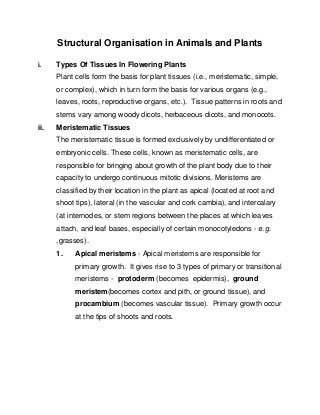
Study Structural Organisation in Animals and Plants for MH-CET 2014
- 1. Structural Organisation in Animals and Plants i. Types Of Tissues In Flowering Plants Plant cells form the basis for plant tissues (i.e., meristematic, simple, or complex), which in turn form the basis for various organs (e.g., leaves, roots, reproductive organs, etc.). Tissue patterns in roots and stems vary among woody dicots, herbaceous dicots, and monocots. ii. Meristematic Tissues The meristematic tissue is formed exclusively by undifferentiated or embryonic cells. These cells, known as meristematic cells, are responsible for bringing about growth of the plant body due to their capacity to undergo continuous mitotic divisions. Meristems are classified by their location in the plant as apical (located at root and shoot tips), lateral (in the vascular and cork cambia), and intercalary (at internodes, or stem regions between the places at which leaves attach, and leaf bases, especially of certain monocotyledons - e.g. ,grasses). 1. Apical meristems - Apical meristems are responsible for primary growth. It gives rise to 3 types of primary or transitional meristems - protoderm (becomes epidermis), ground meristem(becomes cortex and pith, or ground tissue), and procambium (becomes vascular tissue). Primary growth occur at the tips of shoots and roots.
- 2. 2. Lateral meristems ==> Vascular and cork cambium is responsible for secondary growth. Secondary growth is not common to all plants, predominates in woody species. In the dicot plants, there is a process of growth that begins after a known period of primary growth. Such a growth is known as secondary growth. It is the result of the activity of secondary meristem. It results in the formation of secondary permanent tissues such as secondary xylem, secondary phloem and secondary cortex. As a result, secondary growth brings about an increase in the girth of the plant body. i. vascular cambium, increases girth of stem, replaces dead phloem and xylem. ii. cork cambium – phellogen add cork and parenchyma cells to replace the damaged epidermis 3. Intercalary nodes Another type of meristem active in certain plants, especially grasses, is the intercalary meristem. These cells possess the ability to divide and produce new cells, as do apical and lateral meristems. They differ, however, in being situated between regions of mature tissue, such as at the base
- 3. of grass leaves, which are themselves located on mature stem tissue. iii. Simple Tissues ∙ Parenchyma - found in roots, stems and leaves, undifferentiated thin-walled, large vacuoles, often contain secreted material (starch, oils, tannins, crystals). ∙ Aerenchyma - parenchyma tissue with extensive intercellular air spaces (e.g. water lilies and spongy mesophyll of leaves). ∙ Chlorenchyma - parenchyma with numerous chloroplasts (common in leaves). ∙ Collenchyma - thick-walled but flexible and strong, usually right below the epidermis of a leaf or stem, used for support in stems and leaves of non-woody or young plants. ∙ Sclerenchyma - thick walls impregnated with lignin, usually dead at maturity, function is support. ∙ Sclerids - stone cells in pear, hard part of seeds and nutshells (cells are long as they are wide). ∙ Fibers - much longer in length than they are wide, fibers are used in rope, textiles, canvas, paper money (common sources are hemp, cotton, and flax).
- 4. For more information visit www.ednexa.com - Team Ednexa
